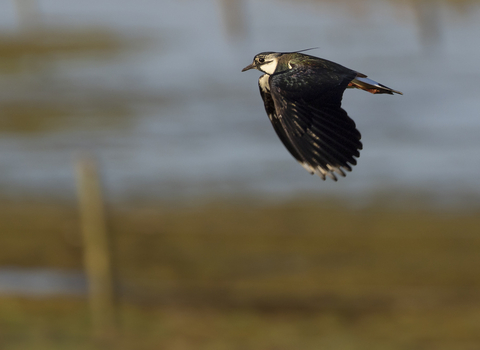It’s been a busy and productive year. From the excitement of fledgling spoonbills at Hickling Broads and Marshes, the first known breeding success in the Norfolk Broads in around 400 years, to co-designing our new urban nature reserve, there is so much to celebrate.
This is the first year that we are reporting against our new strategy: A Wilder Norfolk for All, formally launched externally in September 2023. It guides us to 2030 and beyond as we build on strong foundations, raise our ambitions to meet the scale of the challenges facing nature and remain responsive to our changing environment.
We have set out a clear vision and mission for the future of Norfolk’s wildlife and people, underpinned by clear delivery plans to achieve the essential outcomes — and as you can read here, we are making great stride. We hope you enjoy reading about all we have achieved – we couldn’t do it without your support.
You can download the full pdf and plain text versions of the report, or read the full text below.
Download the full impact report pdf
Jump to a section
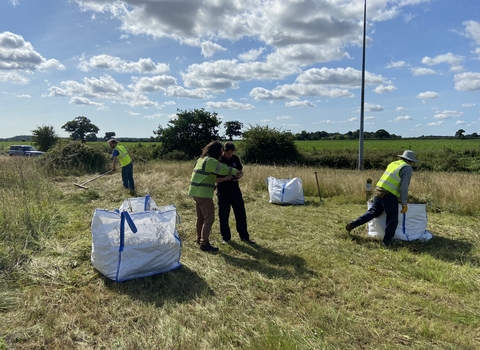
Green hay collecting (credit: NWT)
Abundant and thriving nature
We will achieve a strong and connected recovery for nature across Norfolk
As well as doing fantastic work every day across our 66 nature reserves to make them true exemplars, we undertake ambitious large-scale projects to achieve our goal of a strong, connected nature recovery across Norfolk.
Adapting our nature reserves to a changing climate: Cley and Salthouse Marshes:
We completed major work to help the reserve and its wildlife adapt to rising sea levels and protect its freshwater habitats. In previous winter storms, huge volumes of shingle have been pushed by waves onto the marshes, blocking parts of the ‘New Cut’ — a huge drain located on the north side of the reserve that removes saltwater from the site.
We realigned and restored the most vulnerable section of the New Cut, making it less likely to be filled with shingle. North Norfolk experienced strong winds and a high tide shortly after work was completed, and saltwater was kept from moving onto our freshwater habitats.
By creating dykes, restoring a creek system and a reedbed pool, we provided habitat for fish and other wetland wildlife, and in turn food for birds such as bitterns. The project was funded by grants from the Environment Agency — Anglian Eastern Regional Flood and Coastal Committee, and the Farming in Protected Landscapes programme, along with generous donations from NWT supporters, including Cley Bird Club and the family of Robert Gillmor.
More space for rare Brecks wildlife:
Expanding ancient habitat in The Brecks for the rare northern pool frog is the focus of an exciting initiative, funded by Natural England’s Species Recovery Programme. Together with the Woodland Trust and Amphibian and Reptile Conservation Trust (ARC), we are creating a tapestry of wildlife habitats on land adjacent to NWT Thompson Common to allow the existing pool frog population to move and grow.
We restored six buried ice age ponds, known as ghost pingos, which form ideal conditions for pool frogs, on neighbouring Mere Farm. Support from members allowed us to purchase this land a few years ago. Excitingly, all the pingos are holding water, and plants have begun to germinate, such as common water-crowfoot, an indicator of good water quality. Meadow creation also began — using native grasses and wildflowers, enhanced with seed from Thompson Common. Staff and volunteers planted over 1,400 native trees, such as blackthorn, spindle and buckthorn.
Restoring our wetlands for wildlife:
We opened 2024 with an exciting new project making vital improvements to rare wildlife-rich wetlands near Kings Lynn. Thanks to £210,350 from the FCC Communities Foundation as part of the Landfill Communities Fund, Grimston Wetscapes builds on decades of work to successfully restore Roydon Common and Tony Hallatt Memorial Reserve for wildlife and focuses on improving the way water is managed across the sites.
Work included restoring a former stream, creating pools and scrapes, and installing fencing. Common frogs and toads now enjoy the pools, while pied wagtails and stonechats feed in the damp, squidgy margins. The fencing will encourage dense thickets of scrub for a range of nectar and pollen feeding insects, plus insect-feeders such as willow warblers.
Norfolk Wildlife Services:
Norfolk Wildlife Services (NWS) continued to provide professional services to Anglian Water, English Heritage and a variety of other developers and domestic clients. Work included supporting clients with adapting to the newly introduced Biodiversity Net Gain requirements for developments and supporting UKPN to increase the biodiversity value within their electrical substations.
All profits made by NWS are donated to Norfolk Wildlife Trust for nature conservation.
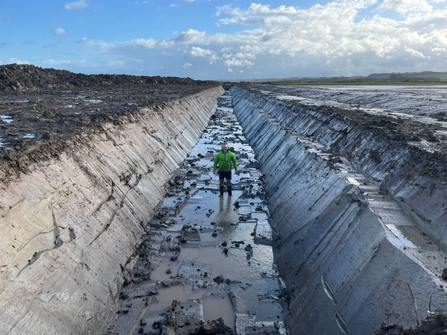
Cley New Cut (credit: NWT)
Case studies
Monitoring what we do:

Water Vole (Arvicola amphibius), Kent, UK - Terry Whittaker/2020VISION
We launched a programme of work to enhance wildlife monitoring across our nature reserves to standardise and digitalise our approach. This included setting up a monitoring pilot project at Cley and Salthouse Marshes, development of digital data collection methods, plus developing a new system for logging rare plant species across our reserves. And it’s not just nature that we monitor — we trialled automated visitor counter technology at Cley and Upton Broad.
Habitat management and wildlife monitoring was the focus at Sweet Briar Marshes, our new urban nature reserve, as we continued the ‘discovery phase’ of the project ahead of the reserve opening to the public. Norfolk Wildlife Services helped to establish an ecological baseline for the site, including using methods such as environmental DNA. This flagged species such as water vole that had been using specific ditches, and will inform site management and further surveys going forward.
Bringing back our peatlands

Four spotted chaser (credit: Steve Evans)
We’ve been working with Fens East Peat Partnership (FEPP) to identify areas across west Norfolk that have potential for peatland regeneration. Last year, focusing on four of the most promising sites, we collaborated with landowners to create detailed plans for restoration.
Around 200 hectares of farmed or forested land will be taken out of commercial management and restored to create substantial mosaics of reedbed, fen and wet grassland.
Re-wetting these sites and promoting new habitats will support a wide range of fenland plants, invertebrates such as dragonflies and damselflies, water voles and iconic bird species
such as crane, bittern and marsh harrier. Just as importantly, these projects will also make a meaningful contribution to our fight against climate change. This work is made possible thanks to funding from the Natural England ‘Nature for Climate — Peatland Restoration Grant’.
Restoring and connecting priority habitats:
We expanded our Nature Recovery team and produced a new strategy, setting out our plans for how we will work with others across the county to reverse the loss of nature and instead see abundant and thriving wildlife all around.
Our County Wildlife Sites (CWS) are key to our nature recovery work, providing vital habitats and stepping stones for wildlife across Norfolk. We offered advice on 61 CWS detailing how to bring the land into the best condition for nature. Thanks to an additional team member, we also resurveyed 60 woodland and priority grassland sites. Up-to-date records help us give accurate advice to landowners and guide our responses to development proposals.
As part of our Network for Nature project, funded by National Highways, we restored meadow, fen and ponds on CWS at Scarning and Silfield. The impact of this work will be measured over the next couple of years by determining if our new habitat creation has led to an increase of key indicator species, such as great crested newt. Funding from Norfolk Rivers Trust enabled us to provide locally sourced green hay and hand-collected wildflower seeds to 19 sites across the county to enhance floral diversity and safeguard key target species such as sulphur clover.
Across Norfolk we advised over 20 landowners on how to enhance habitats on their farms including hedge management, pond restoration and connecting the landscape for the benefit of wildlife. We worked in partnership with Norfolk County Council to maintain and protect 120 Roadside Nature Reserves. Over the last two years, we have been supporting the council in their ambition to increase the network by 180 sites. Roadside verges often contain the last remnants of ancient meadow flora, so are vital in restoring biodiversity.
As part of the Brecks and Fen Edge & Rivers Landscape Partnership scheme, funded by the National Lottery Heritage Fund, we have been running a project restoring ghost pingos within The Brecks and exploring the science behind achieving the best restoration results. Last year, we excavated four pingos bringing the total to 16 over three years on Watering Farm and across Norfolk. Together with other experts including University College London and the Norfolk Geodiversity Partnership, we produced new guidance on the restoration of these ancient ponds.
We continued to champion wildlife through the planning system by ensuring that any impacts are considered both in strategic plans, where the policies that apply to all development are set, and in individual planning applications. We responded to 223 planning applications, making recommendations on 23 of them and objecting to nine where impacts on CWS or other areas of importance for wildlife were unacceptable.
In partnership with other conservation organisations, we continued to warn of catastrophic damage to one of the UK’s most important wetlands if a proposed tidal barrier on The Wash goes ahead. Our Planning and Advocacy Manager spoke at a public meeting attended by over 500 people in Hunstanton. Our presentation highlighted the global importance of this vital estuarine environment for nature and people, and provided evidence of the disastrous impacts on wildlife of comparable developments around the world.
Will Nash sweep netting and panning at Sweet Briar Marshes (credit: Denzil Dean)
People valuing nature
People across Norfolk are connected to, inspired by and taking action for nature
We worked in new and creative ways to inspire even more people to join us in our quest for a wilder Norfolk.
We recruited more new memberships than in any previous year with a record-breaking 37,905 members as of end of March 2024, a growth of nearly 4% on the year before. We were also delighted to see a 40% increase in young people joining us as part of a family membership.
An incredible 451 volunteers took part in corporate work parties, the highest number ever recorded. At our new Sweet Briar Marshes nature reserve, 380 volunteers contributed 2,000 hours of conservation work as part of a mix of corporate, public and youth groups.
Volunteers also play a vital part in our Churchyard Conservation Scheme. The 13-strong team recorded plants and other wildlife across 39 churchyards. We ran 37 churchyard activities, including survey days, workshops (from wildflower identification to scything) and advice visits, attended by over 200 people.
We launched Wilder Schools, a pilot initiative to empower Norfolk schools to use their grounds for wildlife, learning and wellbeing. Supported by the NWT Children and Nature Fund and Friends of Holt Hall, Wilder Schools aims to improve school grounds for biodiversity in the long-term, contributing to nature’s wider recovery. Focusing first on three Norfolk schools, Fairhaven Primary School, Angel Road Junior School and Mile Cross Primary School, we organised assemblies and conducted school sessions where children could discover their outdoor environment and local nature, along with providing training sessions for teachers. Expanding our work with children and young people is integral to meeting our strategic goal of inspiring 1 in 4 people in Norfolk to act for nature by 2030.
Wilder Wardens, our practical conservation group for young people, continued to thrive and grow. We held monthly sessions with a group of up to ten 11–25-year-olds at Hickling Broad and Marshes. The young people got involved in tasks such as hedge planting, bridge building, making a hibernaculum, cutting back vegetation for visitor access — and lots more!
It was our third year of Wilder Communities — a series of workshops aimed at supporting individuals of all ages to act for nature within their neighbourhood. We ran 20 sessions, attended by over 290 people, who gained knowledge on a wide range of topics, from how to plant a wildflower meadow to how to create a poster for a nature event. We also provided communities with specialised advice on managing land for wildlife, from ponds and meadows to new woods, delivering 43 sessions to 130 people. We met the increasingly high demand for this service thanks to a new dedicated team member.
Our Nextdoor Nature programme, supported by the National Lottery Heritage Fund, flourished in its second year, demonstrating the value of empowering communities to lead the way in creating change where they live or work. We supported over 100 practical activities and events within the Mile Cross area of Norwich. Residents also set up the nature-focused Green Hearts group — actions so far have included setting up a community garden and creating a wildflower patch. Our Nextdoor Nature work will inform our wider urban programme, helping us to inspire even more people to act and care for nature in towns and cities
Making connections:
- Connected over 11,000 children and young people with nature on our reserves, in education settings, and at events
- Gained 4,493 new followers across our social media channels
- Received over 600 entries to our photography competition

Lefroy Road Estate Urban Wild Project (credit: Jimmy King)
Case studies:
Sweet Briar Marshes – a community-focused approach
Aside from its superb biodiversity, the urban location of NWT Sweet Briar Marshes provides new and exciting opportunities to connect more people with the natural world.
We asked local communities and members what they wanted from Norwich’s newest nature reserve to help create a shared vision. Every one of the 1,000 people we heard from provided us with vital insights. Most shared our desire that the area should be kept as natural as possible, with facilities to enable people to connect with nature. Together we generated the ideas and feelings that our landscape architects, Sheils Flynn, used to guide the design. We also ran over 50 events on site so people could come and explore ahead of the official opening in May 2024.
Sweet Briar Marshes can be wild and accessible at the same time, and that’s really important.Vision Norfolk
Vision Norfolk visit to Sweet Briar Marshes (credit: Denzil Dean)
We also ran over 50 events on site so people could come and explore ahead of the official opening in May 2024. Many different groups visited, such as families from New Routes, a charity supporting refugees and asylum seekers, as well as Vision Norfolk, a charity supporting people living with sight loss and visual impairment.
Inclusive Norwich gave us advice and support to help us ensure Sweet Briar Marshes would be accessible for all. Their Vice Chair, Rachael Andrews, who is sight impaired and has a guide dog, and Chairperson Dave Shraga who uses a wheelchair, advised on vital aspects such as the type of accessible path to install.
Inclusive Norwich will continue to help us with our ongoing designs to make Sweet Briar Marshes as accessible as possible, for which we are very grateful.
Find out more about our newest nature reserve:
norfolkwildlifetrust.org.uk/SweetBriar
Hickling Vision
In 2023, we purchased a plot of land at Hickling Staithe which included the Pleasure Boat Inn pub, adjacent buildings and a large car park, together with associated moorings.
We purchased most of the other land around the pub in 2017 and the pub is the ‘missing link’ to help realise our vision for wildlife and people in and around Hickling Broad and Marshes. This move sees us developing our vision for the area’s wildlife and people, working alongside the local community.
In addition to taking care of this unique and vital landscape for wildlife, we aim to create facilities that will provide new opportunities for everyone to experience Hickling’s fantastic wildlife in an area where nature, the community and the local economy are all thriving.
Investing in a popular local pub is the first step in allowing us to create new ways to introduce people to the nature, landscape and wildlife of Hickling, including walking routes and a growing programme of boat trips from the staithe. It will also provide us with a new source of income to support our work.
Next steps will be to find a suitable business partner to run the pub on our behalf and we will continue to work alongside the community to develop our Hickling vision.
Find out more: norfolkwildlifetrust.org.uk/PleasureBoatIn
Our visitor centres:
We completed a major new project to revamp the facilities at Ranworth Broad, improving visitor facilities and access to the site, adding new information and signage as well as offering new family-focused activities.
This is all aimed at making the reserve an even better place to explore Norfolk’s iconic wildlife and learn more about the importance of wetlands in the Bure Valley. A hide donated by Acle St Edmund C of E Primary School was relocated to Ranworth, overlooking a quiet, previously inaccessible area of water, where we also created an otter holt and a kingfisher bank. Plus, we added a new bike shelter to encourage visitors to cycle to the reserve.
The transformation was made possible thanks to a variety of our supporters, including Essex & Suffolk Water, Norwich Freeman’s Charity, The Ranworth Trust, The Bure Valley Conservation Group and contributors to the Children and Nature Fund.
At Cley and Salthouse Marshes visitor centre, we hosted a retrospective exhibition of the work of Robert Gillmor,
renowned Cley-based artist, former president of the Society of Wildlife Artists and long-term supporter of
NWT. Robert’s work is well known in the world of natural history, not least for gracing the covers of the New Naturalist series. Robert’s beautiful lino prints celebrate the natural world and many were inspired by the wildlife of Cley Marshes.
Visitor centre highlights:
- We welcomed 175,000 people to our visitor centres, served an incredible 87,000 hot drinks and 18,000 scones!
- 23,000 visitors gift aided their reserve entries to NWT. Gift Aid is one of the simplest and most effective ways of giving to charity, allowing us to claim 25p for every £1 that is donated.
- 7,000 visitors enjoyed wildlife boat trails
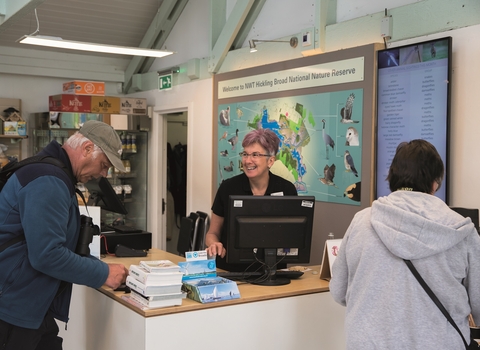
Staff at Hickling visitor centre (credit: Jimmy King)
Leaders for nature
An influential, resilient and collaborative trust.
We focused on building strong foundations this year, from installing more efficient systems to investing in our people, as well as maximising our impact through collaboration.
Achieving the very best for Norfolk’s wildlife means that we need robust, efficient systems and processes to support our people and the amazing work they do.
As part of the Building Foundations for the Future project funded by the National Lottery Heritage Fund, we prepared to launch a new finance system and began work on our new website, which will offer a fresh design, revamped content and a more streamlined structure. We also completed work on securing a new payroll provider. This year also saw the successful implementation of a new ‘electronic point of sale’ system across our five visitor centres to ensure they run smoothly, efficiently and provide excellent customer service. The new technology is already driving sales activity, improving stock management, as well as enhancing staff, volunteer and visitor experience.
A newly recruited ‘Head of People and Culture’ will help ensure we have a healthy, happy team at NWT to unleash their full potential for nature. They led an all-staff engagement event to start work on determining our organisational values. A new staff forum has provided an important opportunity for our strategic leadership team to hear from representatives across the Trust.
A pay structure review was carried out to make sure our salaries are competitive, enabling us to recruit and retain the best talent. We have also ensured that all our staff will be paid the Real Living Wage in 2024/25 and it is our intention to continue to do so.
We formed an Equality Diversity and Inclusion (EDI) working group to focus on this important area. The Wildlife Trust has produced a Diversity Dashboard, which we’re using to gain a better understanding of our staff and will guide us in our efforts to be an equal opportunities employer.
We started working with new membership recruiters who are enabling us to have a regular presence around the county such as at retail venues, local events and visitor attractions. This provides us with increased opportunities to meet and engage new members and raise more essential funds for wildlife.
Our Sweet Briar Marshes project provided excellent collaboration opportunities. We shared our vision of a wilder Norwich, with our new nature reserve at its heart, with Norwich City Council and the Greater Norwich Growth Board — receiving positive responses. An exciting new partnership will see Norfolk. and Norwich Naturalists’ Society conducting monitoring work at Sweet Briar Marshes over the next two years.
Raising awareness of the role nature has in addressing the climate crisis was a focus this year. We dedicated an issue of our Tern members’ magazine to the topic inviting climate change specialist, Dr Jeff Price from UEA’s Tyndall Centre, to write the central article and showcasing how our work, such as protecting Norfolk’s peatlands, can make a difference. Reducing carbon emissions across all areas of our work continues to be a key goal. We added two electric vans to our fleet and an electrical charging point at our Norwich HQ.
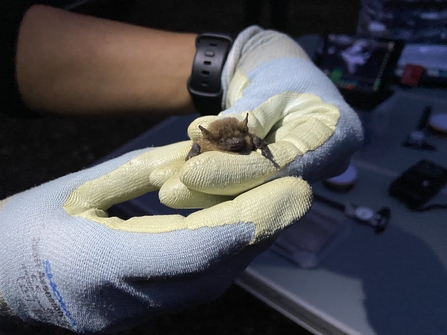
Dr. Charlotte Packman holding a bat whilst out bat monitoring (credit: NWT)
Case study
Working together to protect the wildlife of the Wensum Valley
Our campaign against the proposed Norwich Western Link road development became even more urgent as Norfolk County Council (NCC) received the green light to submit a planning application.
Together with other environmental groups, we continued to warn of the devastating impact of the road on the UK’s largest known barbastelle bat super-colony — evidenced in new research carried out by NWT conservation scientist Dr Charlotte Packman and shared with NCC and Natural England (NE). Over 18,000 people also signed a joint petition against the road that was delivered to County Hall.
Natural England subsequently placed ‘favourable conservation status’ on the barbastelles, which provides a further barrier to the road going ahead. However, the decision prompted outcry from supporters of the scheme who labelled the bat guidance as ‘arbitrary’. We wrote a letter backing the dedicated work of Natural England to the Rt Hon Steve Barclay MP, DEFRA Secretary of State co-signed by national organisations including The Wildlife Trusts, RSPB, The Woodland Trust, Buglife and Butterfly Conservation.
Keep up to date:
norfolkwildlifetrust.org.uk/NWL
Growing support for our work
Corporate support grew significantly as more businesses focused on supporting nature and biodiversity as part of their sustainability strategies. From over 90 ‘Investors in Wildlife’ to major sponsors for projects, the commercial sector contributes hugely to the success of our work. Important in-kind contributions also surged, including substantial IT support and technology from Melbek, and energy-saving new chiller cabinets
provided by Foster-Gamko.
Sweet Briar Marshes project partners, Aviva, continued to be integral to the success of our new urban reserve, contributing a further £300,000 as we built our new team, restored habitat, and created infrastructure ahead of its opening to the public. Generous funding from Biffa Award, as part of the Landfill Communities Fund, paid for the essential infrastructure needed to introduce cattle to the marshes — vital for improving the site for wildlife.
We secured funding from The National Lottery Heritage Fund, with thanks to players of the National Lottery, towards an exciting project that helps us scale up our impact and build a stronger, more resilient organisation. The funding will support our new Building Foundations for the Future project, as we look to empower more people from all backgrounds to value and act for nature locally. A new senior youth engagement role will help us create and deliver inspirational, youth-led opportunities for young people to connect with nature and amplify their voice within our work.
Our Children and Nature Appeal which supports our ongoing programme of work to create more opportunities for Norfolk’s children and young people to connect with nature, was a great success, with over £15,000 generously donated so far. Fundraising throughout our communities continued through collections, sponsored challenges and honouring loved ones through donations in memory. We were grateful to receive over £3,450 from our collection boxes.
Support in numbers:
- Over £800,000 pledged by grant-giving bodies to deliver work over the next two years to improve habitats on our nature reserves, better engage with young people and improve the efficiency of our work by modernising our internal systems
- Four new companies joined as ‘Investors in Wildlife’, bringing our total to 91
- An extraordinary £2.25 million received from people who had generously remembered Norfolk Wildlife Trust in their Wills
- £17,750 kindly donated in memory of friends and loved ones
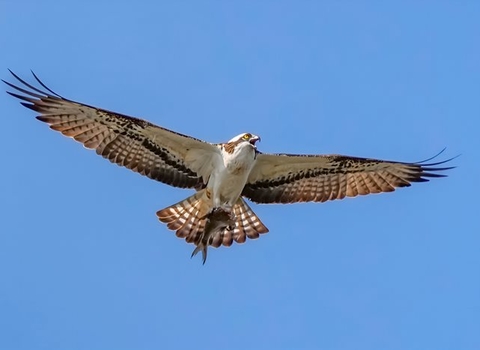
Osprey with its catch at NWT Ranworth (credit: Lynne Warner)
Looking to the future
A message from our CEO
I’m delighted that we were able to hit the ground running in our delivery of A Wilder Norfolk for All, and the previous pages highlight what we’re doing right — inspiring hundreds of people to act for nature, standing up for wildlife, finding innovative ways to improve and connect landscapes to benefit the natural world, and so much more. We are rightly proud of our achievements, yet we must continue to strive to magnify our impact to respond to the scale and gravity of the nature and climate crisis that confronts us. How we respond to this will determine the quality of life for generations to come, in Norfolk and beyond. Alongside all our regular work, we will focus on priorities identified in our strategy, to create an even greater impact.
Outcome 1: Abundant and thriving nature
We will focus our efforts for nature’s recovery in key areas of Norfolk to create landscape scale demonstrations of how we can collaborate to achieve greater impact. We will expand the advice and support we offer to farmers and landowners to help them bring their land into the best condition for wildlife, by utlilising the rich depth of expertise within our staff teams. And we will start delivery of projects harnessing ‘green finance’ income streams such as biodiversity net gain, nutrient neutrality, and carbon credits.
Alongside this, we will continue to target significant and strategic land acquisitions, which will drive Norfolk’s nature recovery.
Outcome 2: People valuing nature
We will continue our focus on bringing nature to new audiences. Plans include furthering our work with young people by setting up a Youth Forum and a Youth Advisory Board; and building on our urban work in Norwich, following the successful launch of our Sweet Briar Marshes nature reserve. We also look forward to developing our vision for wildlife and people in and around Hickling Broad and Marshes nature reserve, with the newly purchased Pleasure Boat Inn providing exciting opportunities to introduce people to the unique landscape and wildlife of the area.
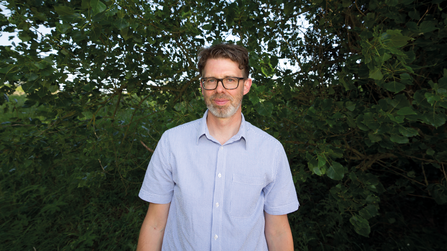
Eliot Lyne (credit: Jimmy King)
Outcome 3: Leaders for nature
We will continue to transform our systems and processes, focusing particularly on IT and digital infrastructure and finalising our finance system implementation. Continuing to invest in income generation will also be a key focus, building on record membership figures. Vitally, we will keep building our influence with increased campaigning activity and work with elected representatives to ensure they speak up for Norfolk’s nature.
So, there is much to do, but with your support, all this remains possible, and we will achieve it together.
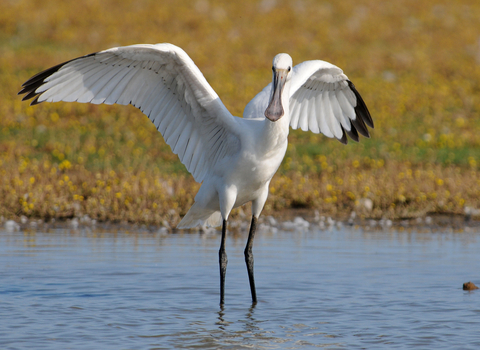
Spoonbill wading at Cley (credit: Nick Appleton)
Financial summary

Detailed NWT income and expenditure for the year ending 31 March 2024 (including subsidiaries)
Income for years 2024 and 2023
Donations and legacies
2024 - £3,770,000
2023 - £2,998,000
Charitable activities
2024 - £2,225,000
2023 - £1,959,000
Other trading activities
2024 - £1,480,000
2023 - £1,323,000
Investment income
2024 - £415,000
2023 - £244,000
Other income
2024 - £289,000
2023 - £281,000
Total income
2024 - £8,179,000
2023 - £6,805,000
Expenditure for years 2024 and 2023
Nature conservation
2024 - £4,087,000
2023 - £3,228,000
Nature recovery
2024 - £637,000
2023 - £478,000
Education activity
2024 - £631,000
2023 - £552,000
Fundraising and publicity
2024 - £590,000
2023 - £667,000
Other trading activities
2024 - £1,568,000
2023 - £1,449,000
Membership servicing and recruitment
2024 - £607,000
2023 - £352,000
Total expenditure
2024 - £8,120,000
2023 - £6,726,000
Net losses or gains on investments
2024 - £305,000 gain
2023 - £205,000 loss
Net income
2024 - £364,000 gain
2023 - £126,000 loss
Total funds brought forward
2024 - £25,157,000
2023 - £25,283,000
Total funds carried forward
2024 - £25,521,000
2023 - £25,157,000
Group balance sheet as at 31 March 2024
Fixed assets and Investments
Tangible fixed assets
2024 - £14,785,000
2023 - £13,854,000
Investments
2024 - £3,912,000
2023 - £3,608,000
Total fixed assets and Investments
2024 - £17,462,000
2023 - £17,462,000
Current assets
Stock
2024 - £107,000
2023 - £96,000
Work in progress
2024 - £31,000
2023 - £31,000
Debtors
2024 - £1,669,000
2023 - £2,031,000
Cash term deposits
2024 - £1,353,000
2023 - £3,653,000
Cash in hand and at bank
2024 - £4,684,000
2023 - £2,715,000
Total current assets
2024 - £7,844,000
2023 - £8,526,000
Creditors: amounts falling due in less than one year
2024 - £1,020,000
2023 - £831,000
Net current assets
2024 - £6,824,000
2023 - £7,695,000
Total Assets
2024 - £25,521,000
2023 - £25,157,000
Restricted Funds
2024 - £12,415,000
2023 - £12,754,000
Unrestricted Funds – General
2024 - £3,300,000
2023 - £1,798,000
Unrestricted Funds – Designated
2024 - £9,806,000
2023 - £10,605,000
Total Funds
2024 - £25,521,000
2023 - £25,157,000

